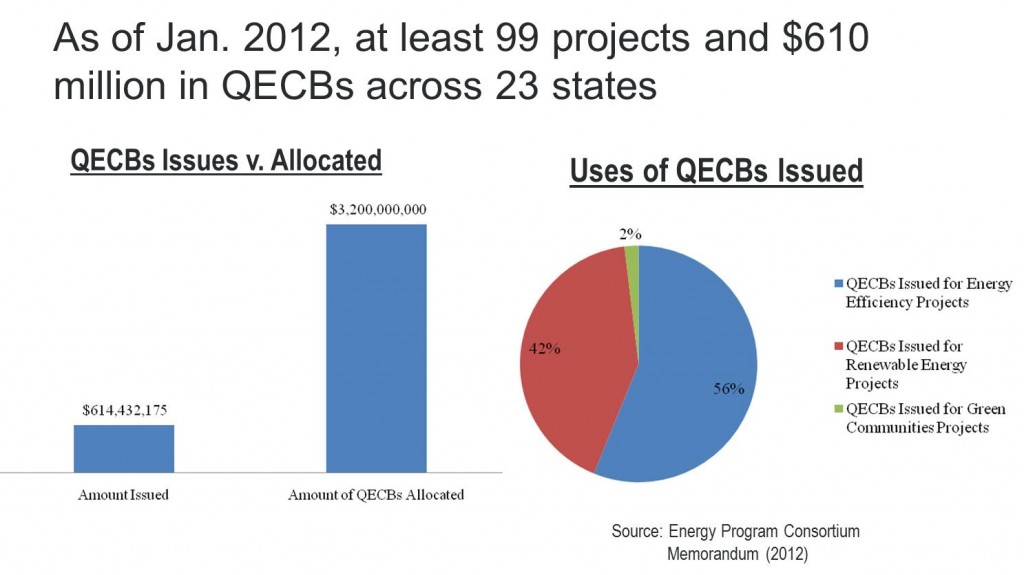Michael Chasnow is a Finance Analyst with the Environmental Finance Center.
Qualified energy conservation bonds (QECBs) are an exciting tool that states, counties and cities can use to cheaply finance energy efficiency and renewable energy projects within their jurisdictions. QECBs are similar to Build America Bonds (“BABs”) in that the interest on QECBs is taxable but the federal government offers a direct cash subsidy to the bond issuer to subsidize the interest costs. The subsidy on QECBs is twice as large as the BAB subsidy at about 4% (4.29% as of Aug. 21, 2012), making QECBs an extremely low-cost financing option for state and local government issuers. For more on the QECB essentials, check out DSIRE’s detailed description.
Here at the EFC, as part of our DOE Technical Assistance work, we have been working with the states of North Carolina and Tennessee to help inform cities and counties about QECBs, the types of projects that qualify and lessons learned from across the United States. As part of this initiative, the EFC held a web session with 20+ local government representatives in NC and 30+ local government reps from Tennessee. We are also following up individually with counties and cities that are moving forward with the QECB process.
Through this process, I have noticed few key takeaways about QECBs that I wanted to share. Some of these are on the positive side, while others are on the negative. Regardless, it is exciting to see local governments grappling with the decision of whether and how to take advantage of this cheaper financing opportunity:
- Use of QECBs is on the rise: Going into 2012, after being available since 2009, $600M of the $3.2B allocated by the Treasury Dept. had been used (as seen in the graphic above). Through the first 7.5 months of 2012, the amount of QECBs issued jumped to over $1 billion, more than a 66% increase. Moreover, the mid-2012 QECB update from the IRS have created more clarity regarding the types of projects that qualify, and reporting requirements.
- Great range of projects completed: Elizabeth Bellis at the Energy Programs Consortium (EPC) does a great job of documenting how QECBs are being used in different states, counties & cities across the country. From $3.8 million in municipal energy efficiency projects in Waterbury, CT, to a $131 million QECB project in LA to fund 15MW of new wind power, to a $10.7 million for a residential energy efficiency program in St. Louis, MO that has already led to financing for more than $1 million in residential retrofits, impactful projects are using QECBs nationwide.
- State implementation varies in success: As Bellis notes in her EPC memo, some states like Kansas and Kentucky have already used all of their QECB allocations, while other states are just starting to launch their programs. As we have learned from working the states of North Carolina and Tennessee, 70% of a state’s allocation goes to counties and cities with over 100,000 in population (allocations are based on size of the city/county), and engaging government leaders at the local level is key to success. State energy offices that do not clearly communicate the QECB process, and the mechanics, to eligible local governments will struggle to increase engagement and use of QECBs.
- An example of good state communication from Tennessee: Tennessee just launched its QECB program a few months ago, and its Economic and Community Development (ECD) team has done a great job of engaging local government officials, creating an easy to use website to access information and guidance on QECB use within the state. Moreover, the ECD team has a created a listserv for local government officials and stakeholders engaged in the QECB process, and asked cities and counties to update the state on plans to use Oct. 5th, 2012. These bonds do not have an end date, but by putting in place a concrete time for local governments to respond by should help push action and local government use of QECBs. Local governments are excited to learn more and participate, and the 30+ local governments that joined our discussion last week is evidence. With the ECD team engaging and guiding local governments through the QECB process, I expect some great energy projects to come out of Tennessee in the next year or so.
QECBs are a great tool for state and local governments to cheaply finance energy efficiency and renewable energy projects. With increased clarity from the IRS, a growing track history of QECB projects, and intentional & effective local government engagement by state energy offices, we hopefully will continue to see an uptake in QECB use. We at the EFC are excited to do our part!


